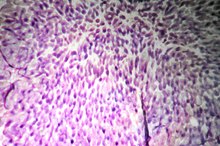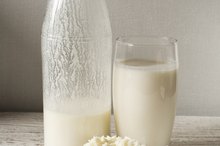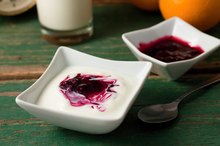What does fact checked mean?
At Healthfully, we strive to deliver objective content that is accurate and up-to-date. Our team periodically reviews articles in order to ensure content quality. The sources cited below consist of evidence from peer-reviewed journals, prominent medical organizations, academic associations, and government data.
The information contained on this site is for informational purposes only, and should not be used as a substitute for the advice of a professional health care provider. Please check with the appropriate physician regarding health questions and concerns. Although we strive to deliver accurate and up-to-date information, no guarantee to that effect is made.
Food With Lactobacillus
Lactobacillus is a lactic acid bacterium naturally found in the gastrointestinal tract and vagina. Many strains of lactobacillus exist and are commonly used to process and ferment foods. Lactobacillus is considered a probiotic--a live microorganism that may benefit health when consumed. Benefits of lactobacillus in the diet include reduced lactose intolerance; prevention of yeast infections; control over diarrhea and symptoms associated with irritable bowel syndrome; prevention of cancer, allergies and eczema; improved immunity and less severe infections; and decreased cholesterol.
If you are experiencing serious medical symptoms, seek emergency treatment immediately.
Yogurt & Kefir
L. acidophilus, L. bulgaricus and L. plantarum are all strains of lactobacillus used to make yogurt and kefir, a yogurt-like product originating from Turkey and Persia 4. Bacterial cultures are added to milk to ferment and thicken the final product. Studies published in the “Journal of the American College of Nutrition” and the “Annals of Internal Medicine” found that eating yogurt had the potential to lower the risk of coronary heart disease and yeast infections.
Acidophilus Milk
Non-Dairy Probiotic Drinks
Learn More
Lactobacillus acidophilus is added to milk for its probiotic properties and because it is believed to be easier to digest than regular milk for lactose intolerant individuals. There are two types of acidophilus milk: Sweet milk is refrigerated immediately after the bacteria is added, while a tart version is allowed to ferment prior to refrigeration.
Miso & Tempeh
Miso is a fermented soybean paste, and tempeh is made from fermenting whole soybeans; both are used in Asian cooking. Lactobacillus is used during fermentation to control the growth of undesirable bacteria.
Sauerkraut
Are There Probiotics in Sour Cream?
Learn More
Sauerkraut is traditionally fermented with naturally occurring bacteria found on cabbage; however, in commercial manufacturing, a bacterial culture is added. Sauerkraut that has been pasteurized does not contain lactobacillus because the pasteurization process kills the bacteria.
Buttermilk, Sour Cream, Cheese
Lactobacillus and other bacteria such as streptococcus are used to make some buttermilk, sour cream and cheese. The process for making these products is very similar to that of yogurt, but differs in the strain of bacteria used and the length of fermentation. Bacteria cultures used to make cheese add acid and flavor to the final product.
Supplements
Lactobacillus supplements come in tablet, capsule and liquid forms. The dosage at which a supplement is beneficial is being researched, and different supplement brands may contain different strains and dosages. According to the National Institutes of Health, possible side effects of lactobacillus supplements are abdominal cramping and gas, which may be controlled by limiting the dose taken.
Related Articles
References
- “Annals of Internal Medicine”; Ingestion of yogurt containing Lactobacillus acidophilus as prophylaxis for candidal vaginitis; Hilton, E., Isenberg, HD., Alperstein, P., France, K., Borenstein, MT.; March 1992.
- “Journal of the American College of Nutrition”; Effect of fermented milk (yogurt) containing Lactobacillus acidophilus L1 on serum cholesterol in hypercholesterolemic humans; Anderson, J.W., Gilliland, S.E.; 1999.
- Dairy Council of California: Focus on Healthy Eating
- University of Maryland Medical Center: Lactobacillus acidophilus
- Selle K, Klaenhammer TR. Genomic and phenotypic evidence for probiotic influences of Lactobacillus gasseri on human health. FEMS Microbiology Reviews. 2013;37(6):915-935. doi:10.1111/1574-6976.12021
- Brusaferro A, Cozzali R, Orabona C, et al. Is It Time to Use Probiotics to Prevent or Treat Obesity? Nutrients. 2018;10(11):1613. doi:10.3390/nu10111613
- Kadooka Y, Sato M, Ogawa A, et al. Effect of Lactobacillus gasseri SBT2055 in fermented milk on abdominal adiposity in adults in a randomised controlled trial. Br J Nutr. 2013;110(9):1696-703. doi:10.1017/S0007114513001037
- Cribby S, Taylor M, Reid G. Vaginal microbiota and the use of probiotics. Interdiscip Perspect Infect Dis. 2008;2008:256490. doi:10.1155/2008/256490
- Strus M, Chmielarczyk A, Kochan P, et al. Studies on the effects of probiotic Lactobacillus mixture given orally on vaginal and rectal colonization and on parameters of vaginal health in women with intermediate vaginal flora. Eur J Obstet Gynecol Reprod Biol. 2012;163(2):210-215. doi:10.1016/j.ejogrb.2012.05.001
- Itoh H, Uchida M, Sashihara T, et al. Lactobacillus gasseri OLL2809 is effective especially on the menstrual pain and dysmenorrhea in endometriosis patients: randomized, double-blind, placebo-controlled study. Cytotechnology. 2011;63(2):153-61. doi:10.1007/s10616-010-9326-5
- Shin SP, Choi YM, Kim WH, et al. A double blind, placebo-controlled, randomized clinical trial that breast milk derived-Lactobacillus gasseri BNR17 mitigated diarrhea-dominant irritable bowel syndrome. J Clin Biochem Nutr. 2018;62(2):179-186. doi:10.3164/jcbn.17-73
- Dang Y, Reinhardt JD, Zhou X, Zhang G. The effect of probiotics supplementation on Helicobacter pylori eradication rates and side effects during eradication therapy: a meta-analysis. PLoS ONE. 2014;9(11):e111030. doi:10.1371/journal.pone.0111030
- Boumis E, Capone A, Galati V, Venditti C, Petrosillo N. Probiotics and infective endocarditis in patients with hereditary hemorrhagic telangiectasia: a clinical case and a review of the literature. BMC Infect Dis. 2018;18(1):65. doi:10.1186/s12879-018-2956-5
- Dang, Y.; Reinhardt, J.; Zhou, X.; and Zhang, G. The Effect of Probiotics Supplementation on Helicobacter Pylori Eradication Rates and Side Effects During Eradication Therapy: A Meta-Analysis. PLoS One. 2014 Nov 3;9(11):e111030. DOI: 10.1371/journal.pone.0111030.
- Itoh, H.; Uchida, M.; Sashihara, T. et al. Lactobacillus Gasseri OLL2809 Is Effective Especially on the Menstrual Pain and Dysmenorrhea in Endometriosis Patients: Randomized, Double-Blind, Placebo-Controlled Study. Cytotechnology. 2011 Mar;63(2):153-61. DOI: 10.1007/s10616-010-9326-5.
- Jung, S.; Lee, K.; Kang, J. et al. Effect of Lactobacillus Gasseri BNR17 on Overweight and Obese Adults: A Randomized, Double-Blind Clinical Trial. Korean J Fam Med. 2013 Mar;34(2):80-9. DOI: 10.4082/kjfm.2013.34.2.80.
- Kadooka, Y.; Sato, M.; Ogawa, A. et al. Effect of Lactobacillus Gasseri SBT2055 in Fermented Milk on Abdominal Adiposity in Adults in a Randomised Controlled Trial. Br J Nutr. 2013 Nov 14;110(9):1696-703. DOI: 10.1017/S0007114513001037.
- Pendharkar, S.; Brandsborg, E.; Hammarstrom, L. et al. Vaginal colonisation by probiotic lactobacilli and clinical outcome in women conventionally treated for bacterial vaginosis and yeast infection. BMC Infectious Diseases. 2015;15:255. DOI: 10.1186/s12879-015-0971-3.
Writer Bio
Bethany Fong is a registered dietitian and chef from Honolulu. She has produced a variety of health education materials and worked in wellness industries such as clinical dietetics, food service management and public health.









